The best handlebar bags carry your spares, layers and snacks securely while keeping them out of the elements, yet easy to access.
A handlebar bag was once a rarely seen accessory, reserved for touring bikes and shoppers on hybrids.
But the emergence of gravel bikes and bikepacking has made handlebar bags cool, and better designs and materials have made them more useful.
Keep reading to see our pick of the best handlebar bags or jump to our buyer's guide where we explain what to look for when choosing the best bar bag for your needs.
Best handlebar bags
Apidura Racing Handlebar Pack

- £70 / $93 / €84 / AU$131 as tested
- Pros: Waterproof; easy zip-free opening; hi-vis graphics; secure attachment
- Cons: Head tube strap fiddly to fit
- 2l
The Apidura Racing Handlebar Pack is a high-quality and easy-to-access bar bag for tools, spares and snacks.
Designed to be fully waterproof, don’t let the name put you off using the Racing Handlebar Pack for everyday use.
Unlike most bar bags, which are cylindrical in shape, Apidura’s 2l-capacity, semi-rigid offering is envelope-shaped. A front Velcro-flap opening rather than a zip makes access easy, even while riding.
The lightweight laminate Hexalon material features welded rather than stitched seams, which boosts waterproofing. This is great news if you often ride in the wet or want to stash things such as a power bank or spare layers.
Branding is more flashy with this bag. But it's for good reason, with hi-vis yellow and reflective graphics on the front and sides boosting visibility.
There’s a loop on the front for attaching a light, as well as a smaller internal mesh pocket for smaller items. The integrated straps are very sturdy and also feature removable spacers.
Rapha Explore Bar Bag

- £65 / $80 / €75 / AU$110 as tested
- Pros: Good selection of colours; two compartments; weather resistant; wearable with shoulder strap; rugged materials
- Cons: Non-removable shoulder strap
- 2.4l
The Rapha Explore Bar Bag is just the right size for spares and kit, while still being handy and secure.
Building on the popularity of Rapha’s original bar bag, the Explore Bar Bag is designed to cope with the demands of off-road riding. There’s nothing stopping you using it on tarmac too.
A small front compartment comes in handy for small items such as used snack wrappers. A roomier main section can take a jacket, pump, knee warmers and snacks, both secured with chunky zips and storm flaps.
The main part also has a length of elastic across the back to help organise spares, tools and keys.
To improve weather resistance, the Nylon outer has a PU coating internally and a DWR-treated outer. The seams have been taped inside the main compartment.
The tough Hypalon back is designed to protect the head tube from scratches, with the fixed shoulder strap tucked in behind. We only wish the shoulder strap was removable.
Topeak Tubular Barbag

- £67.99 / $89.95 / €69.95 as tested
- Pros: Generous capacity; clever bungee design; stable strap attachment; internal divider; rigid construction; protective tape supplied
- Cons: Not fully waterproof
- 3.8l
Generous capacity, handy extra features and rigid construction make the Topeak Tubular Barbag one of the best handlebar bags on the market.
Boasting a mighty 3.8l capacity and a rigid construction, this cylindrical bar bag is a wonderfully versatile option that you could also use for lightweight bikepacking.
Inside, a removable padded divider helps you keep your tools, spares, snacks and extra layers organised in the large compartment. For stashing a pair of gloves or easy-access snacks, there’s a mesh pocket on either side too.
If the 3.8l capacity isn’t enough, there’s a bungee cord on the front of the bag, which you could stash a jacket, flip flops or your supermarket haul in – complete with some cool buckles.
Attachment comes in the form of adjustable Velcro straps backed with silicone for added stability and an elastic cord for the head tube.
Unlike most other brands, Topeak also supplies a sliver of 3M tape for head tube protection. Neat.
Wizard Works Lil Presto Barrel Bag

- £59 / $74 / €69 as tested
- Pros: Quality Voile strap attachment; bright lining; fun colourways; handmade in UK; rigid construction
- Cons: Not totally waterproof
- 3.4l
The Wizard Works Lil Presto Barrel Bag is fantastic, fun and as practical as it is stylish.
Straight out of London, the Lil Presto Barrel Bag is one of handmade bike bag specialist Wizard Works’ most popular items.
A plastic sheet insert makes the Cordura Nylon cylinder bag rigid, and it's fully lined with yellow Ripstop, making items easy to find inside.
Apart from the roomy main compartment, which can easily accommodate tools, a pump, spares and a jacket, there’s also a shallow pocket on either end that are handy for smaller items.
Purchase the bag with Velcro handlebar attachment loops, or upgrade to rubberised Voile Nano straps (£10), both giving a secure fit.
There are a few extras available when you order: six foam spacers (£6.50) to accommodate cables and allow for more hand positions and a clip-on shoulder strap (£10) for off-the-bike use. There’s also a smaller 1.8l barrel bag on offer for £50 / €69.
Specialized/Fjällräven Handlebar Pocket Bag

- £50 / €60 / AU$100 as tested
- Pros: Fun colourways; easy, secure attachment; durable materials
- Cons: Too small for extra layers; not waterproof
- 1.5l
The Specialized/Fjällräven Handlebar Pocket Bag is a great-quality handlebar bag at a sensible price. But it's only suitable for small items, not extra layers.
With only a 1.5l capacity, the Specialized/Fjällräven pocket bag is more like a pencil case than a hefty bikepacking roll. This makes it perfect for small items such as keys, a phone, tools, spares and snacks.
The colours may be fun, but that doesn’t compromise quality. Robust Velcro straps attach to your handlebar, while an elastic cord stabilises the bag against the head tube.
Internally, the bag is fully lined and features a single compartment. A handy key clip gives extra peace of mind.
It is secured by a two-way zip, which can be undone on the bike, as long as you don’t use an out-front computer mount.
The bag’s small size makes it compatible with almost all bike setups and sizes. However, because the seams are stitched rather than welded, it’s not totally waterproof.
Zéfal Z Adventure F2

- £39.99 / €39.95 as tested
- Pros: Waterproof construction; great value; secure attachment; good capacity
- Cons: Fixed strap position; single colourway; PVC finish
- 2.5l
The Zéfal Z Adventure F2 is a simple but secure bar bag that may not be as aesthetically pleasing as some but offers great value.
The mix-size 2.5L handlebar bag from Zéfal is cylindrical in shape, features a waterproof construction with welded seams and a water-repellent zip. There’s plenty of space for a pump, tools, snacks and a jacket.
Attachment comes in the form of two Velcro, silicone-backed straps which fix securely to the handlebars, and an elastic cord which attaches to the stem.
Unlike some bags which feature ‘daisy-chain’ webbing to enable you to move the position of the straps, these attachment points are fixed. Therefore, the bag is not as versatile for riders with more complex cockpit setups.
The semi-rigid design means that it does droop a little when half-filled, not quite holding its shape.
While branding is minimal, reflective stripes on the front and sides of the bag improve visibility.
The PVC-esque finish may not be to everyone’s taste. But for £39.99, at least it’s very competitive on price.
Also consider
These handlebar bags scored fewer than four stars in our testing, but they are still worth considering if they meet your needs and budget.
Restrap Canister Bag

- £49.99 / $74.99 / €59.99 / AU$99.99 as tested
- Pros: Foam spacer blocks help get great fit; handmade in the UK; enough space for a jacket and spares; lifetime warranty
- Cons: Not as waterproof as rival options; doesn’t hold shape
- 1.5l
The Restrap Canister Bag is a low-cost option that’ll do the job, but not as well as the best handlebar bags.
Handmade in Leeds, the Canister Bag is a mid-sized option. It features a fully lined main compartment with additional external mesh pockets on either end of the cylinder-shaped bar bag.
The bag is certainly bigger than the claimed 1.5 litres, with a capacity more like 2.2l.
A pair of webbing straps come with foam spacing blocks and plastic buckles. An elastic cord keeps the bag in place against the head tube.
There’s a sturdy loop of Hypalon material, which you can use to attach a light on the front too.
Although the bag uses a waterproof zip, it’s not totally waterproof. Rival options with welded rather than stitched seams are better at keeping things dry.
Since there’s no reinforcement to the bag, it doesn’t keep its shape as well as others featuring a plastic insert. This is especially true when loaded with heavier items such as a pump and tools.
Brooks Scape Handlebar Pouch

- £60 / $80 / €70 as tested
- Pros: Waterproof construction; provision of foam spacers; storm flap
- Cons: Squeaky spacers; bag doesn’t hold shape when loaded; not the most secure straps
- 3l
The Brooks Scape Handlebar Pouch is a decent capacity bar bag that doesn’t match its rivals' rigidity and secure fit.
The mid-sized 3L capacity cylindrical handlebar bag has a fully waterproof design. It uses a welded rather than sewn construction and the waterproof zipper covered by a storm flap.
Two webbing straps with aluminium buckles attach to the handlebar and a Velcro webbing strap secures the bag to the head tube.
Six EVA foam blocks of two different depths are supplied to help you get the best fit on your bike. Though they tend to be squeaky on the ride.
A daisy-chain of webbing on the front enables you to attach a light. Hypalon loops on either end can accommodate a shoulder strap (not included). For longer trips, it can be added atop the Scape Handlebar Roll as an accessory pouch.
Brooks’ bag hangs down from the bars rather than against them. It doesn’t hold its shape as well as more rigid bags when loaded with heavier items like tools and spares.
Why you can trust BikeRadar
BikeRadar has been an authority on bikes and cycling tech since its inception in 2007, delivering the world’s best riding advice.
We have experts testing all types of bikes, parts, clothing and accessories, from road, mountain and gravel bikes to commuting, bikepacking and electric bikes.
Our reviews are always editorially independent – with no exceptions. Our reviewers comprehensively test all products in the real world, always reflecting on performance, value and the wider market when delivering their verdicts and review ratings.
We have more than 15,000 product reviews available at your fingertips, as well as expert buying, maintenance, training, skills, health and fitness advice.
Our annual Bike of the Year test is an industry benchmark and the BikeRadar team consists of some of the most experienced riders and testers in the business.
What is a bike handlebar bag?

A bike handlebar bag is simply a bag that you can attach to your handlebar, usually via straps that go around the tops of the bar, near the centre.
Access may be via zips or a roll-top end closure. In both cases they are usually designed to help keep moisture away from the bag’s contents.
The proliferation of sizes and designs means there’s a handlebar bag, also known as a bar bag, for practically every use.
Who uses handlebar bags?

In the past, almost no one used handlebar bags, except for the hardcore touring cyclist. But in recent years, handlebar bags have come into vogue, mainly thanks to the rise of gravel bikes.
Bar bags are a handy alternative to saddle bags. Like top tube bags, they make it easier to access your possessions and offer a little more protection from wheel spray and dirt.
A bar bag is also a good place to keep a mid-ride snack, freeing up pocket space or enabling you to ride in a pocketless cycling jersey.

There’s usually a little more capacity than in a saddle bag, so you can add a cycling gilet or waterproof jacket in case of rain, or use the bar bag to stash accessories such as arm warmers or a cap if it warms up during your ride.
A bar bag paired with a larger seat pack, frame bag or other bikepacking bags provides the main carrying capacity for adventure riding. The supplemental capacity is easily accessible if you’re using panniers on a touring bike.
Handlebar bags are also a good way to carry extra kit and work materials, or a laptop if you’re commuting on a hybrid bike or folding bike.
The different types of handlebar bag
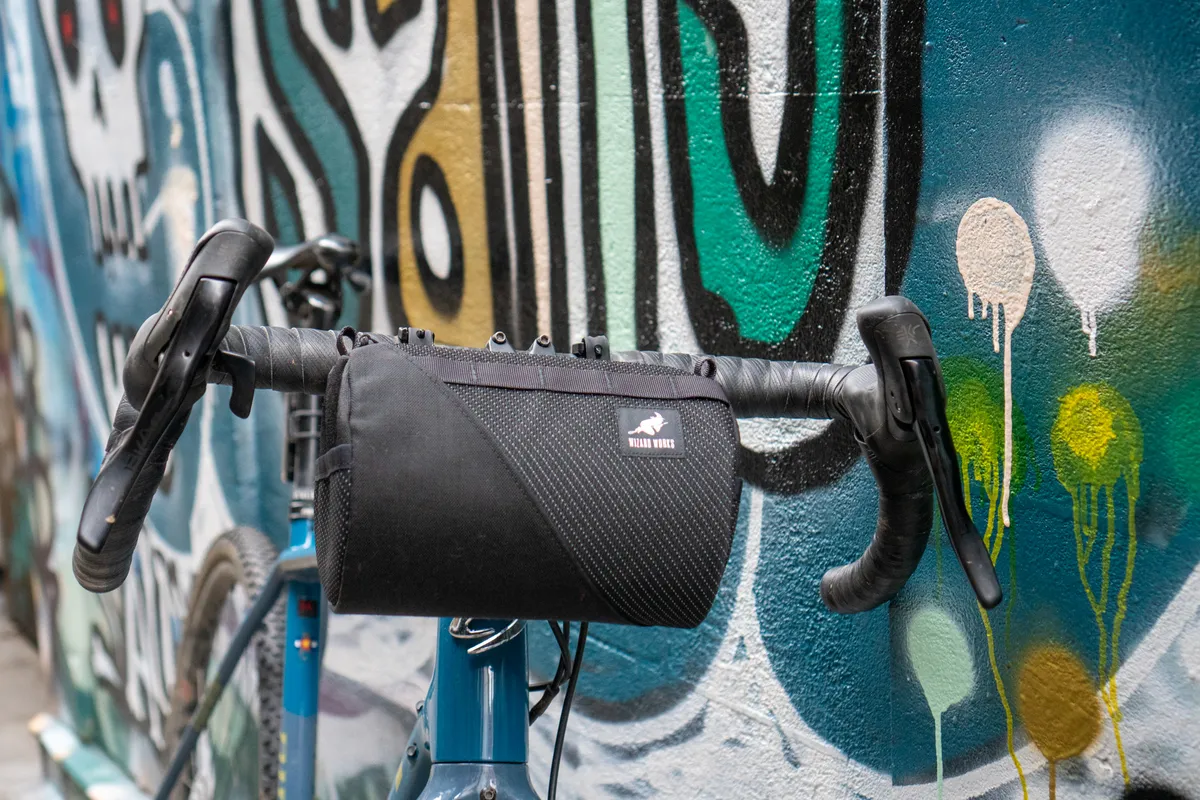
Handlebar bags come in a range of designs, often dictated by their size.
Small handlebar bags
Small handlebar bags tend to be cylindrical in shape with one zip across the top or front. They’re good for tools and snacks, but may limit what else you can carry, although they may include webbing straps for outside carrying.
There’s a gradation of sizes as you scale up. Some bags are available in multiple sizes with essentially the same design, but different capacities.
Open-top handlebar bags
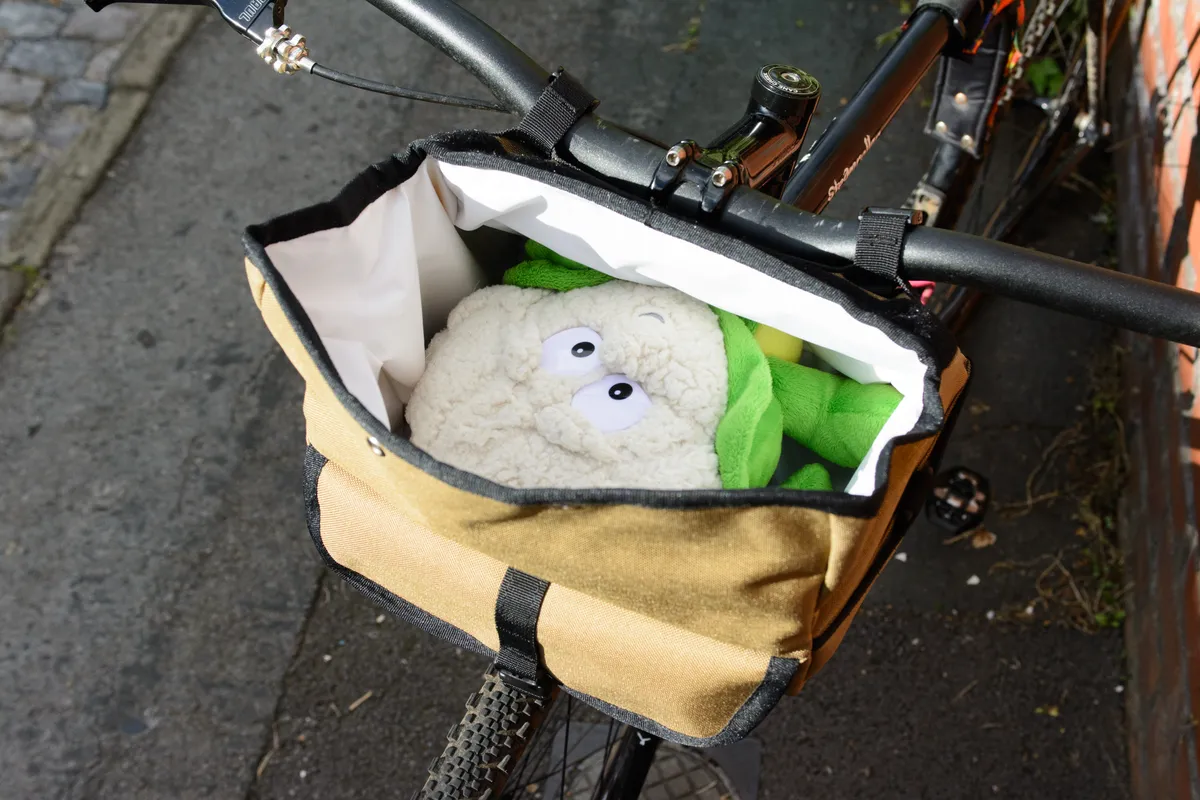
One common design has a top opening to access the contents, often supplemented by a sleeve on the lid and maybe side pockets. Bags of this type tend to be quite rigid.
Waterproof dry bags
The other popular design for larger bags is a waterproof dry bag, which sits in a sleeve attached to the bike.

This is advantageous for bikepacking because the sleeve can be left on the bike, while you can take the dry bag elsewhere.
It’s a good system for carrying a sleeping bag or down jacket, keeping the contents dry but still easy to access when you stop, and is also used for some of the best bikepacking saddle bags.
Having said this, the sausage shape may interfere with a bike’s drop handlebar or brakes. Large handlebar bags may have multiple compartments. The largest Restrap bag incorporates both a rigid compartment and loops below it for a dry bag.
Portable handlebar bags
Finally, some bags are designed for city riders. They are often shaped like a satchel and feature a shoulder strap or handle for off-bike carrying.
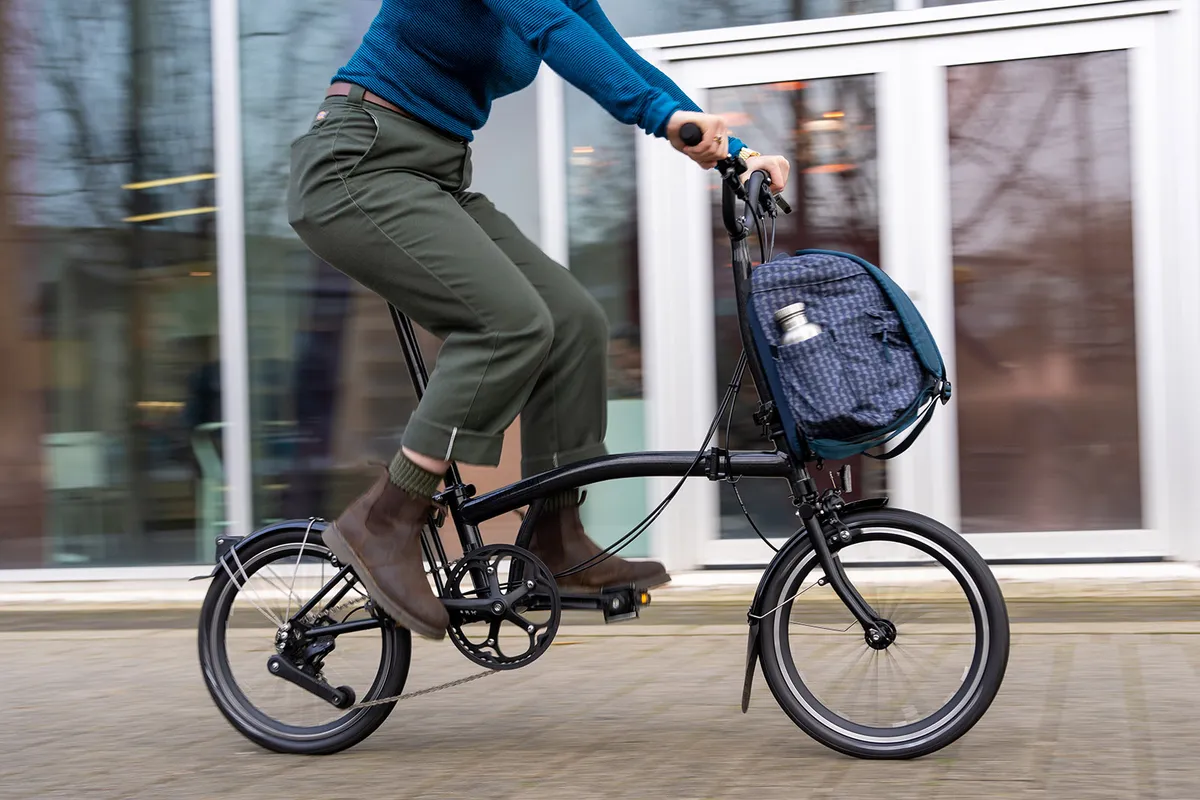
Handlebar bags tend to be sold as universal designs for any bike, but some are intended for a specific bike and sold as an accessory by the bike brand.
Brompton, for example, sells handlebar bags designed specifically for its folding bikes and which attach to the bag mount that’s a feature of the front end of most Bromptons. Sizes for Brompton’s bags are surprisingly generous and offer as much as 23 litres of capacity.
What to look for in a bike handlebar bag
Size

The key consideration when choosing a bar bag is its size. On the one hand, you want enough capacity for your needs. On the other, you don’t want to be riding around with a bag that’s half full – not least because it’s likely to sag and bounce around, and the contents may rattle.
Fortunately, many bar bags enable you to adjust their volume to match your load, often via compression straps. Many also include adjustable bungee cords, so you can lash a jacket to the outside, which has the added benefit of being easy to access when it’s needed.
If you are mostly going for day rides but make the occasional bikepacking trip, you may want two bags to meet your different capacity needs.
Compatibility with your bike

The main issue with bar bags is their width relative to your handlebar. If you have a road handlebar, a wider bag may not fit between your drops on a road bike or may interfere with your grips if you have a flat mountain bike handlebar. It may make using your controls awkward as well.
Gravel bikes are easier in this regard. Gravel bike handlebars are usually wider than road bike bars and flared, so they offer more space and enable you to use the drops more easily, even with a wide bag.
The other issue, particularly with smaller frame sizes, is that a deeper bag can rub on your front wheel, so you need to ensure there’s adequate clearance, particularly since bags tend to droop once loaded.
Mounting system

Many bicycle handlebar bags mount to a handlebar with two straps, usually with a strap further down the bag that passes around the head tube, to help keep the bag stable.
It’s a system that works well, although it can lead to rubbing on either the bar or the frame, so it’s worth adding some protective tape to your handlebar and around the head tube.
Straps may be nylon with standard pull-through buckles, clip-together clips or Velcro to keep them in place. In some cases, rubber is used, which has the advantage of being stretchy and grippy, so your bag is less likely to move around as you ride.
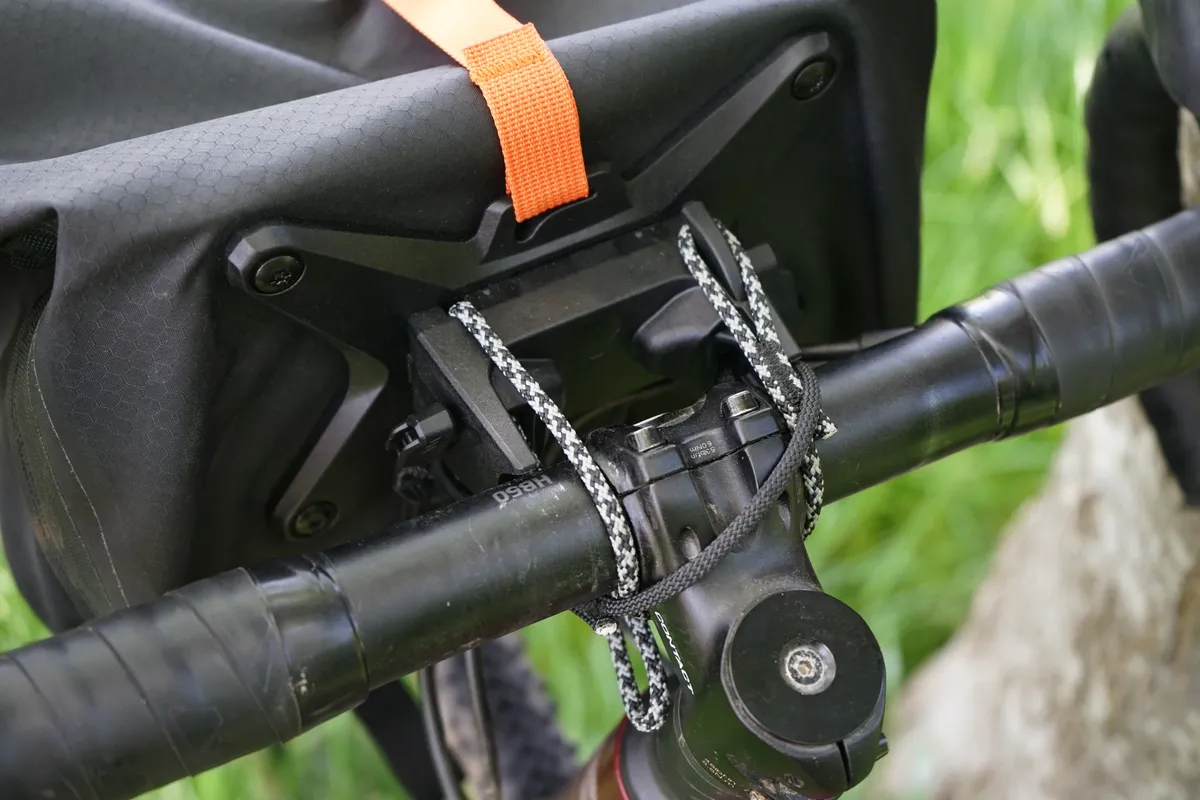
Any strap system can interfere with brake and gear cables. So it’s common for brands to include spacers, usually made of closed-cell foam, to hold them away from the bar slightly and enable the cables to function.
Other brands use a separate mount that fits to the bar and to which the bag is attached.
In some cases, the mount may lift your bag above the level of your bar. This increase rigidity, avoid contact with the front wheel and boost capacity.
Durability
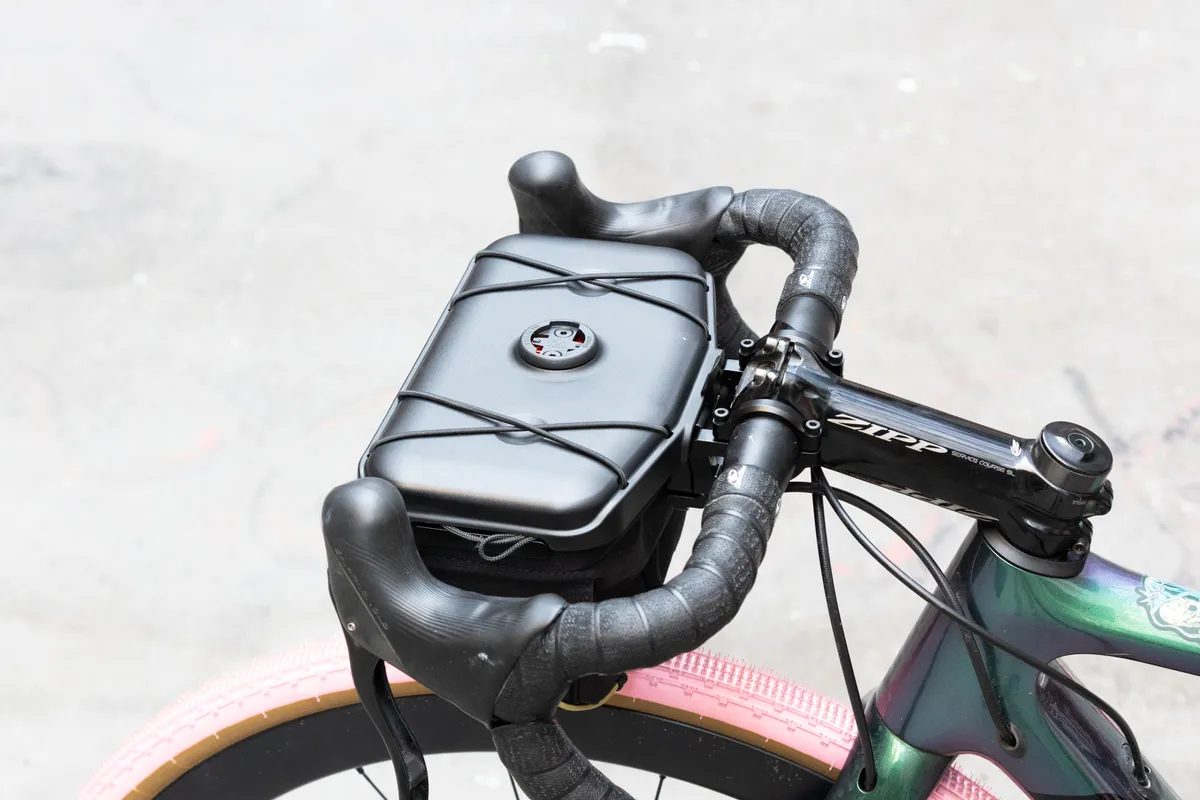
Larger bags, in particular, tend to be made of heavier-weight fabric, which improves their durability.
Often the underside is made of heavy-duty material to make it more durable and weatherproof. Lighter-weight fabric is fine for smaller bags because they have less weight to carry.
Some bags have internal reinforcement. Stiffer materials, particularly in the sections likely to come into contact with the head tube, help keep them rigid. Others may have further reinforced areas or be semi-rigid.
Rubbing against the bike can cause wear. Some bags have patches of more abrasion-resistant fabric where they come into contact with the frame. Straps are less of a problem if they start to fray because they can usually be replaced.
Keep an eye out for wear though and replace them before they are too damaged. You don’t want to contend with a broken strap on a long-planned excursion.
Waterproofing
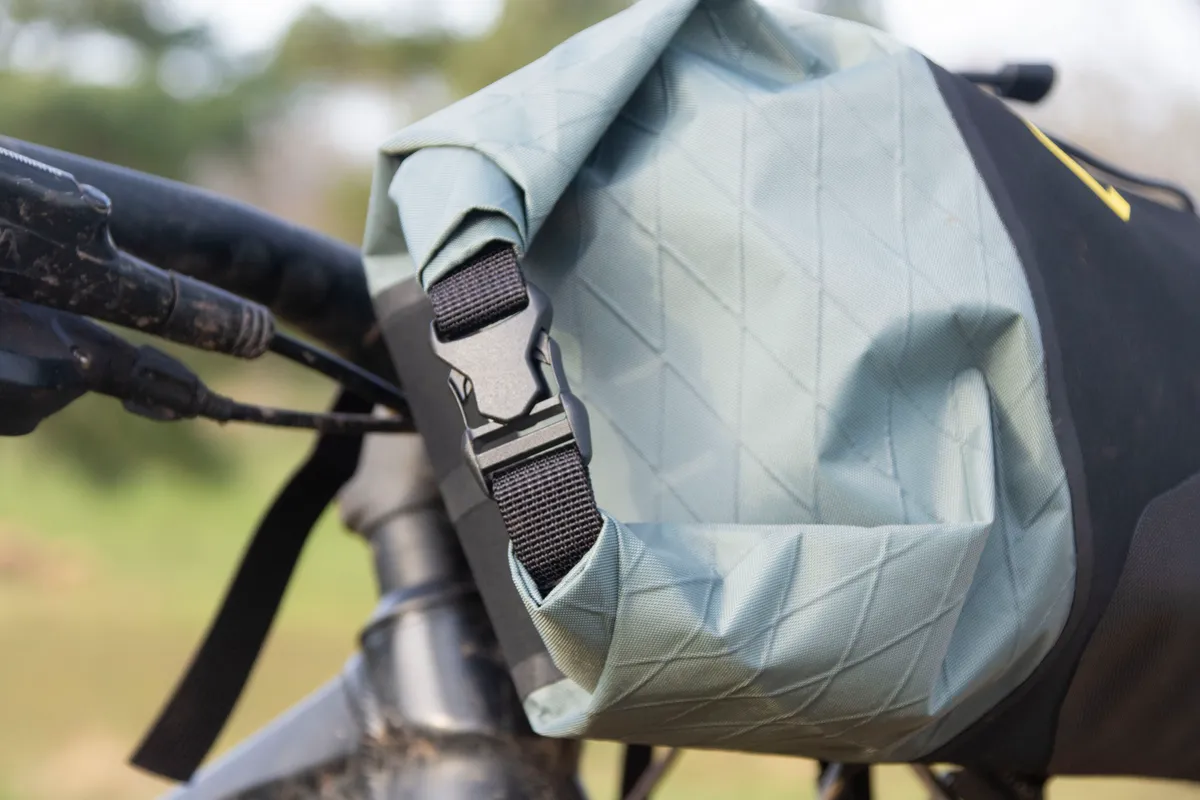
Waterproofing is important, even if you’re mainly riding in the dry.
Wheel spray can wet out the contents if the road is damp. Mud or unavoidable puddles could make a mess of your bar bag’s contents.
Left in a damp bag, tools can corrode quickly and you may find your multi-tool is unusable when you need it.
Fortunately, most bar bags are made with waterproof fabrics. If a bag has zips, these are usually waterproof to stop water ingress. Some include a separate dry bag, usually with a wrap-end closure to stop water from getting in through the opening.
To be sure your contents will stay dry, you can use separate dry bags inside your bar bag. These will also make it easier to organise your stuff.
Pockets and accessibility

You may want to be able to access the contents of your handlebar bag while en route. In this case, extra side pockets can help.
The contents of a dry-bag style bar bag can be difficult to access quickly because you will have to unwrap the end. Plus, there’s usually no internal compartmentation.
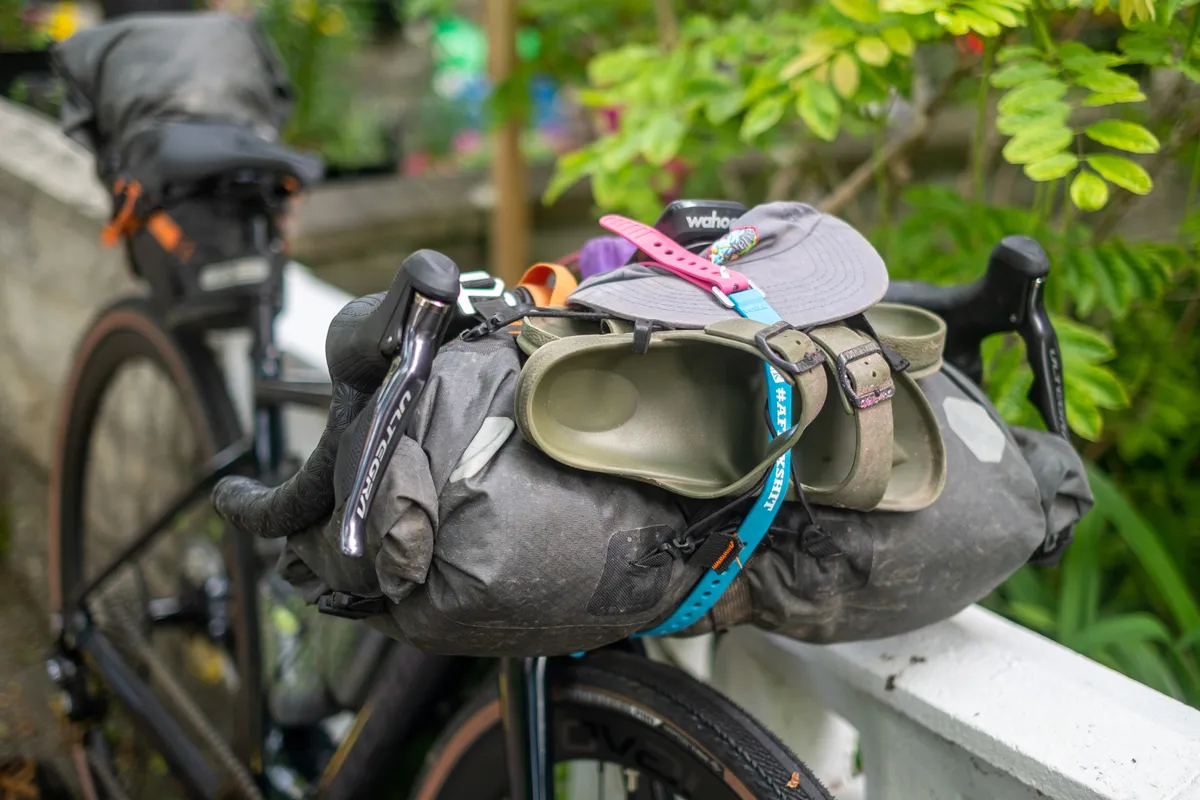
Many bags include bungee straps to lash items to the outside, which can help with access to larger gear such as jackets and camping kit.
Some bags enable you to add extra bags or pockets in a modular design to increase your carrying capacity or include ladders on the outside to add straps.
Many bar bags feature a transparent sleeve on top to stash a bike computer, map or route plan.
Visibility

If you’re an audax rider, it may also be useful to look for a handlebar bag with fixing points for lights.
The handlebar bag may limit fixing points on your handlebar for a front bike light or impede the light’s ability to illuminate the road ahead.
Reflective elements are also handy to increase your safety when cycling at night and in poor weather.

